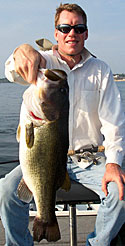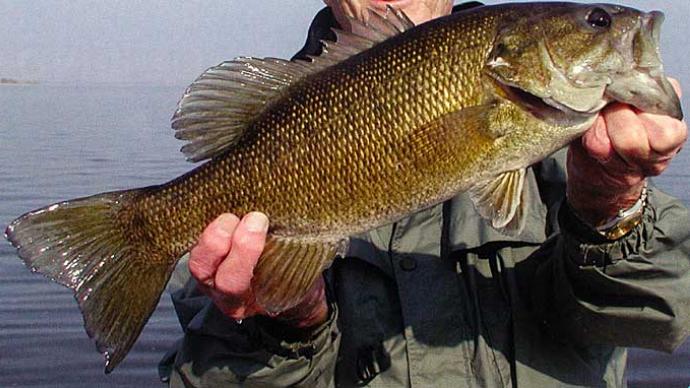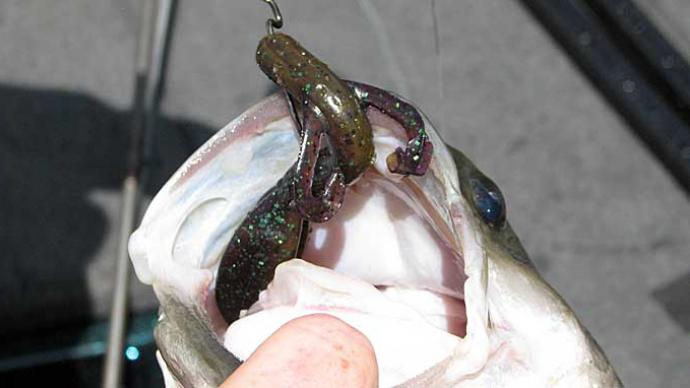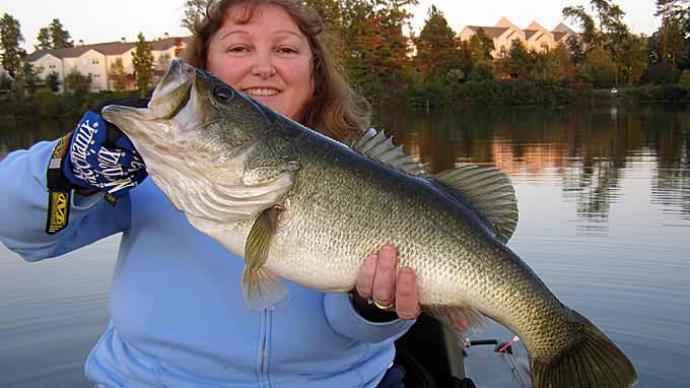
After the lake turns over, late September through November is prime season for the deep-water structure fisherman on Lake Fork. Big bass will also be caught deep through February, although the bite typically slows by late November. Vast schools of shad group up in deep water, and the white bass, yellow bass, and crappie follow them. Being an absolute sucker for all-you-can-eat buffets, tremendous congregations of bass join the action. Happily, they stuff themselves on the shad, crappie, yellow bass, smaller bass, and anything else they can get in their mouths. Learn how to find and fish for these schools, and you'll add your lures to the list of what the bass are eating this fall.
Step one is the hardest part, finding the bass. Depending on the conditions, I find structure bass as shallow as 12 feet and as deep as nearly 50 feet on Lake Fork. A trick to figuring out the most productive depth is I'll watch my Lowrance graph for suspended fish off to the sides of points and humps or over open water. Generally, the depth that fish are suspending in open water is the depth you'll find active fish on top of the structure.
For example, if fish are suspending about 28 feet down in open water, check the tops of humps and points about 28 feet deep, and you'll likely find schools of active fish. Most bass in summer relate to deep structure with significant depth changes nearby like points, humps, ledges, and creek channel bends. While all of these can hold bass in fall, large flats are also often productive in the main lake and near creek channels in bigger creeks. Also, in contrast to summer, fall schools often assemble in barren areas devoid of timber or spots with a few pieces of isolated cover instead of on structure with heavy cover. Bass are on the move a lot this time of year following bait, so spots that are loaded up one day can be barren the next. Use your graph to check lots of deep spots, and don't start fishing until you either find a large school or locate an area with several large arches (fish) on the screen.
Once you've found a good school, catching bass is usually the easy part. Carolina rigs and drop shots are my preferred baits for fish located on or near the bottom. I'll rig a 1-ounce sinker with 20lb fluorocarbon P-Line line and a 36-inch leader on the Carolina rig. On the business end, I'll rig a Lake Fork Tackle Baby Ring Fry, Magic Shad, or 4.5-inch Live Magic Shad. Watermelon, watermelon/red, green pumpkin, watermelon/chartreuse, and albino shad are all great colors to try. Drag this under the schools, with long pauses between pulls.

For pure numbers of bass, it's hard to beat the drop shot. A Twitch Worm or 3.5-inch Live Magic Shad on a drop shot rigged 12 inches above a ½ ounce sinker with 8- to 12-pound P-Line fluorocarbon line works best for me. When the fish are active, a constant twitching of the bait on the slackline works best, while simply dead-sticking the bait on a taught line works better as the water cools or when the bite is tough.
With the bass primarily eating shad, baits that work up off the bottom for suspended fish and imitate dying baitfish excel many days. Jigging spoons, crankbaits, tail spinners, jigs, swimbaits, and even topwater catch lots of bass each fall. Chrome, gold, and white jigging spoons and tail spinners from ¼- to 2-ounces in various shapes and fall patterns work well.
Some spoons and tail spinners fall faster while others flutter down at a slower rate, based on the shape of the spoon or the size of the blade on the spinner. Try multiple baits until you find what the bass prefer. Furthermore, some days these metal baits work best when ripped off the bottom. Other days, they work better when dragged along the bottom or held in place several feet off the bottom.
When the bite gets tough, small ¼ ounce jigs worked slowly through the schools can attract bites from inactive fish, including lunkers. For a sensitive rig with some power for big fish, I'll rig my jigs on 20lb braided line with a 6-foot, 8- to 12-pound test fluorocarbon leader.
On the other hand, if the fish are really chasing shad and actively feeding, shad and yellow bass pattern swimbaits and deep-diving crankbaits deliver fast action. For the swimbait, I like a 4.5 inch, or 5.5-inch Live Magic Shad rigged on a 4/0 to 6/0 extra-wide gap hook with a ¼- to 3/8-ounce weight on the hook shank.
Cast these out on 15- or 20-pound fluorocarbon line, count them down to the depth of the fish, then swim them back in.
As for colors, whites and chromes work great for the crankbaits, while barfish, magic shad, and albino shad are my favorite swimbait colors.
Finally, keep a heavy topwater like a Zara Spook or a ½ ounce chrome lipless crankbait handy to cast when bass chase shad to the surface and rig them on 20lb CXX Mono so they'll stay on top. Keep these long casting baits handy, and you're almost guaranteed a hookup if you drop them into schooling fish.
Suppose you want to learn how to structure fish or if you're looking to catch a lot of fish and maybe a lunker, late fall is hard to beat. Here's hoping you catch the lunker of your dreams.




